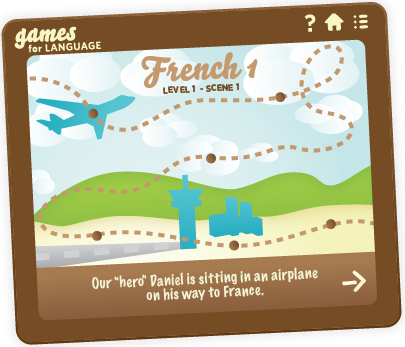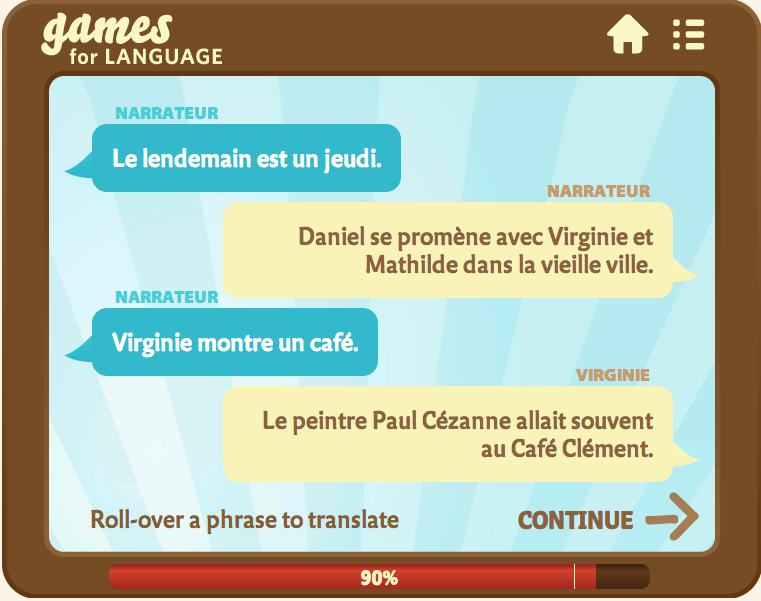The GamesforLanguage Program - Part 1: Approach & Methods
Why have we thrown GamesforLanguage into the mix of self-teaching language programs? It's the games, silly.
If you want to learn a language, you can find plenty of self-teaching language programs. They are available as books, CDs, DVDs, direct downloads, and online. Some well-known names are Assimil, Rosetta Stone, Pimsleur, Fluenz, Michael Thomas, Busuu, Rocket Languages, Duolingo, and others.
While all programs help motivated learners improve their language skills, not all are equally effective for learning to understand, speak, read, and write a foreign language. An online program - including ours - won't make you fluent.
But it can help you acquire a good pronunciation and provide you with vocabulary and basic grammar, which you can then use and practice in real conversations. Just think about it: it's really hard to have a conversation if you have no vocabulary use and don't understand the words that you hear.
The GamesforLanguage learning Program has been designed to teach some essentials of all four (4) language skills. Games are a way for making language learning more fun.
But games - with their special ways to engage your brain - can also make learning more effective, as shown by researchers that study how people learn. For example, see Kathy Sierra’s Crash course in learning theory.
 Entertaining digital games have auditory features (spoken language, sounds), visual components (text, colors, images, design), as well as kinesthetic elements (writing against the clock, clicking on moving images, etc).
Entertaining digital games have auditory features (spoken language, sounds), visual components (text, colors, images, design), as well as kinesthetic elements (writing against the clock, clicking on moving images, etc).
By engaging multiple senses, digital games enhance a learner’s ability to recall and retain new words and expressions. Language learning is about message decoding and communication, and this is not a straightforward process.
Learning a language involves trial and error, a certain amount of confusion, but also plenty of insightful “aha!” moments.
Key Points
Three important points guide our development of the GamesforLanguage Learning Program:
1. Adults can learn a second language more rapidly online when they can relate words, phrases and grammatical structures to their native language. In this way their learning experience is quite different from that of children, who are able to acquire their first language without even knowing how to read and write. This notion is supported by observations of other learners and our own experience.
2. Learning with the help of a story allows you to identify with situations and circumstances you will encounter yourself. This makes the acquired vocabulary not only immediately relevant and useful, but also helps you to memorize it more easily.
3. Learning foreign languages as an adult requires an effort. Playing language games will make this effort fun. Memorizing vocabulary, phrases and sentences, identifying grammar rules and structures all occur "playfully," as you can test and improve your language skills during increasingly more challenging games.
The Program
The GamesforLanguage Learning Program may appeal primarily to teenagers and adults. However, we know that children who have just learned to read and write also enjoy the games.
Our Quick Games work for beginners with little prior knowledge of the foreign language and for anyone who wants some language practice.
Our Courses, on the other hand, are best for learners with some language background. While mid-beginners will spend more time on each scene of a course, more advanced players may be able to move through the scenes quite rapidly.
Throughout each of the courses, you'll accumulate up to 12,000 points by playing various language games. At the same time you'll acquire a working vocabulary of close to 700 essential words and many idiomatic expressions. At the end of a course, you'll also be able to read and understand the entire travel story, which consists of over 2,000 words.
The Structure
Each course consists of 6 levels, with 6 lessons (we call them “scenes”) per level for a total of 36 scenes. So far, the most effective approach has been for learners to do one scene per day (which should take around 15 minutes) and to review an earlier scene for extra recall.
Each lesson builds on the previous one and adds between 16-20 new words to your vocabulary.
The Story
Each scene has a dialogue or narrative of 8-16 lines, which we call “The Story.”  It appears right at the beginning of each scene and once again at the end. At the beginning of each scene, the story challenges you to guess the meaning, based on the (English) introduction and context.
It appears right at the beginning of each scene and once again at the end. At the beginning of each scene, the story challenges you to guess the meaning, based on the (English) introduction and context.
When you get to the end of the scene, you'll have learned all the words and phrases in the various games, and understanding “The Story” will now be easy. This is quite similar to what you would experience when arriving in a foreign country with some language background. (For the impatient player, a roll-over option provides the full translation right away.)
The 36 scenes of a course tell the story of a young man who travels to France, Italy, Spain, Germany or the U.S. From talking with his neighbor in the airplane, greeting his aunt who picks him up at the airport, asking for directions to a friend's house, to ordering food and drink, and chatting with friends, our travel hero uses lots of useful vocabulary. It provides a great start on learning how to communicate.
The travel story engages the learner, provides relevant vocabulary in context, and creates a framework that ties everything together.
Part 2: Games Summary
A next blog post will describe the various games we are using in our program. Our games are not just individual learning clips, nor are they simply an enhancement of a conventional language program. The games ARE the language program. We'll add a summary table that shows the specific skills each game teaches.
